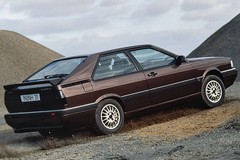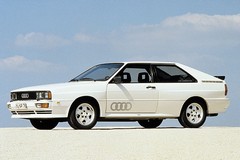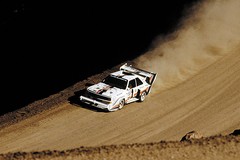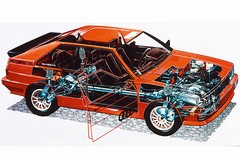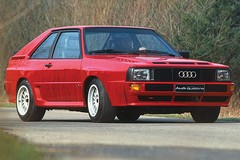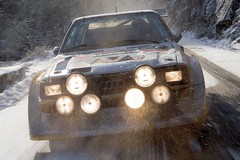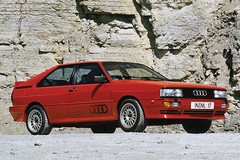PH Heroes: Audi Quattro
David Vivian says happy thirtieth to the car that changed performance motoring forever

The Geneva motor show in 1980. Nice flowers
Thirty-one years ago, all Audis were good but dull. A year later, one had become the most famous car in the world. The Audi making its world debut three decades ago in 1980 didn't just take centre stage on its maker's stand at that year's Geneva salon, it became the focus of the entire show.
The original Audi coupe Quattro celebrates its 30th birthday this years but its birth - bolstered by the breathless prose of a few fortunate hacks who'd managed to score an early drive in highly favourable snowy conditions - so dominated the gossip at the springtime event that other manufacturers were left wondering if they should have even bothered to turn up. The turbocharged, 200 horsepower, four-wheel-drive coupe was greeted by some observers as all but the reinvention of the motor car itself. And, come press day, the world's automotive media had only one word on its lips: Quattro. Right there, right then, the Quattro redefined what a car could do.
The chunky Audi's mix of all-weather grip and grunt seemed so far ahead of the game we all scratched our heads in wonderment. As well we might given its unlikely origins and 'bitsa' engineering approach. Back in the late-'70s, Audi had been developing the Volkswagen Iltis off-road 4x4 for the German army. On winter tests in Finland, the modestly-powered VW ran rings around its more muscular brethren.
This gave Audi's engineers (including one Ferdinand Piech) the idea of developing a high-performance road car with four-wheel drive - one that could be used to the full in almost any conditions. The complete GT and, regulations permitting, ultimate rally weapon. And yet that wasn't really the clever bit. What made the Quattro concept so viable and enduring was that it was essentially a hum-drum amalgam of stock parts slotted together in an extraordinary way.
Audi was already developing the turbocharged 2.2-litre five-cylinder engine for the 200 5T and the basic layout of its cars, with a longitudinal engine and a gearbox just behind the front axle, was easy to adapt to four-wheel drive. The gearbox output shaft simply had to be extended towards the rear and a tail shaft and final drive assembly added. And all the necessary extra driveline hardware could be pinched from the Iltis.
The Audi 80 floorpan and basic bodyshell from the forthcoming Audi Coupe were chosen, even though the 80's dead axle rear suspension wasn't compatible with the 4wd system. It was ditched and replaced by the front subframe and MacPherson strut suspension turned through 180 deg and with rigid track rods holding the steering arms (and allowing for rear toe-in adjustment). Audi 200 drive shafts and disc brakes were used front and rear, and the new power-assisted steering being developed for the Audi Coupe was specified.
Initially, Audi tried to get away without having an inter-axle diff and, although the high-speed performance of prototypes (even with a mere 160bhp) was good enough to keep a Porsche 928 honest around Hockenheim, there was too much tyre scrub in the slower turns and when parking. A light, compact and cheap fix was to adapt the diff from the Audi 50/VW Polo and add it to the back of the gearbox. Dog clutches within this diff (and the rear one) locked them up on the move at any speed.
The all-wheel drive hardware weighed just 165lb more than a light fwd system but only 70lb more than a rear-drive layout, while the anticipated mechanical efficiency losses never materialised. Audi discovered that tyres generate less rolling resistance when driven gently than when freewheeling. Prototypes went faster when driven by all four wheels than when the rear driveshafts were removed.
The road car that shook the world became the rallying legend that spawned generations of point-to-point paradigms similarly culled from mainstream components: Lancia Delta Integrale, Ford Escort Cosworth, Subaru Impreza Turbo, Mitsubishi Lancer Evo. The works rally Quattros more or less cleaned up in the early '80s (especially in the hands of Mikkola and co-driver Arne Hertz) and responded to Lancia's almost overwhelming Group B challenge with the chopped-down Sport versions, which were rumoured to have 450bhp.
So the Quattro shaped the genre of affordable supercars for ordinary blokes. The Quattro evolved, too, and was such a potent weapon on a winding road in its final 1991 220bhp 20-valve incarnation that its currency hasn't significantly devalued 19 years on. Just look at the performance stats: 146mph top speed, 0-60mph in around six seconds, 100mph in eighteen. Two decades on, its performance and all-drive chassis are still right on the pace. It feels modern, supple, subtle and remarkably desirable. Even the boxy style and blistered wheelarches are starting to look good again.
But the Quattro isn't all about straightline stuff. Accelerate hard on the turn and it finds acceleration where lesser cars find wheelspin or a close encounter with the hedge on the other side of the road. There may be faster cars in a straight line, ones that can pull more lateral g on smooth, dry Tarmac. But very few despatch real roads and uncertain conditions with such confidence. No, make that disdain. All right, if we're being frank, the Audi does understeer too much in tight turns and, by contemporary standards, the turbo lag and lack of action at low revs are obvious drawbacks. And its anchors are good rather than great.
But, 30 years ago, the Quattro made dog meat of most cars on a hard road. That included everything from featherweight two-seaters to full-on exotics. The enduring beauty of the experience is the accessibility of that core talent. There's a click-'n'-go simplicity to the Quattro that makes you a better driver than you ever thought you were. You don't need a Pentium Loeb processor in your bonce to do the business. Strap up, drive fast, never want to stop. What remains remarkable is how much of the performance you can safely use, and how often. And how effortlessly.
The Quattro inspires tremendous confidence and, such is its innate surefootedness and four-corner cohesion, road surface changes are less of an issue than in most other cars. As are severe vertical components. True to its rally car DNA, humps and dips hold little fear for the suspension and damping. It's extremely rare to bottom out in a Quattro; stability verges on the absolute.
So, 30 years on, here's a car that urges you to get involved with your driving and do it properly: to brake a little later and turn in a little harder; to get on the power earlier and eat up the next straight.
If the car has a secret weapon, it's probably its uncanny ability to get its power down the instant you nail the apex. It's a cumulative thing. On that long and winding road it can add up to a substantial advantage. So that's the Quattro, a true 20th century icon. Audi may have built a better driver's car in the R8, but it has yet to match the Quattro's impact.
Gassing Station | General Gassing | Top of Page | What's New | My Stuff

